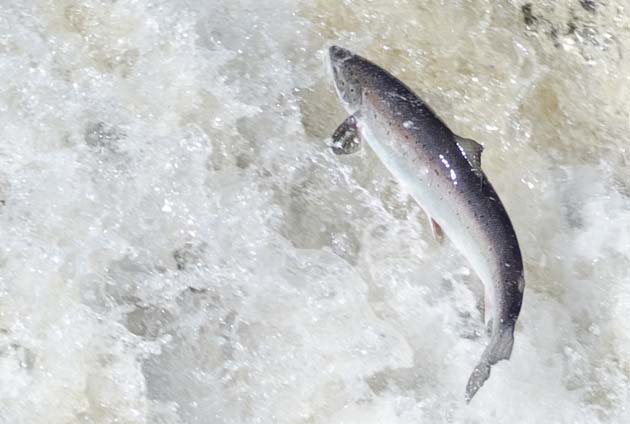New telemetry study shows up to 18 percent of young salmon get eaten by striped bass
Sources: CBC News / Atlantic Salmon Federation / Canadian Journal of Fisheries and Aquatic Sciences / Department of Fisheries and Oceans
[dropcap]S[/dropcap]triped bass (Morone saxatilis), normally a coastal waters feeder, have been preying salmon smolt over 60 miles above tidal waters in iconic salmon areas on the Miramichi River and Restigouche River.
The highest levels of predation were in the northwest branch of the Miramichi, where striped bass go to spawn. There, smolt predation ranged from seven to 18 per cent.
The estimated consumption rate comes as the population of striped bass in the Gulf of St. Lawrence explodes. Anglers reported seeing them from Cape Breton to Labrador, according to the federation.
Smolt survival down twofold since 2000s
In 2016 there were an estimated 318,000 striped bass in the Gulf, up from 5,000 in the mid-1990s. “There’s 300,000-plus fish moving into one 10-kilometre section of river; that’s a lot of fish to pack in there,” said Daniels.
The report says salmon smolt survival in the Miramichi estuary is estimated to have fallen twofold since the mid-2000s.
Daniels said it’s the first study to quantify the degree of predation of smolts in the Miramichi by striped bass.
Between 2013 and 2016, the Atlantic Salmon Federation inserted miniature acoustic transmitters into 514 Atlantic salmon smolts in the Miramichi River. Dozens of receivers were placed in the river and estuary.
At the same time, staff from the Department of Fisheries and Oceans and the province of Quebec tagged 110 striped bass.

Atlantic salmon leaping in northern Newfoundland (photo Tom Moffatt/ASF)
Transmitters differentiate between species
Receivers confirmed both species were in the same place at the same time, with unfortunate results for the salmon smolts.
“The more time they are hanging out together, the more likely predation is to occur,” said Daniels.
Most importantly, the transmitters were specially coded to differentiate each species, allowing scientists to understand how each moved in the water.
“If we saw any smolt tags behaving more like striped bass, then we interpreted that as a smolt had been predated,” said Daniels.
The study indicates large numbers of smolts are being taken by stripers, but notes there are other threats in the Miramichi estuary, including the physiological stress associated with migration, and human causes like pollution.
The impact on adult salmon who eventually return to the Miramichi is not directly correlated. Daniels said the bass could be killing the weak who were doomed to die anyway.
[information]
Atlantic Salmon Federation . . .
Canadian Journal of Fisheries and Aquatic Sciences . . .
[/information]

